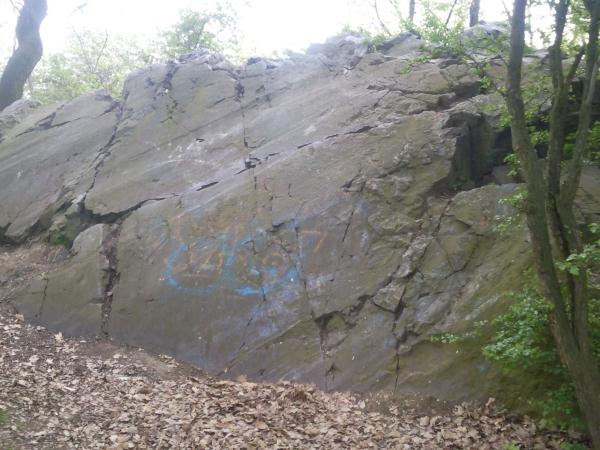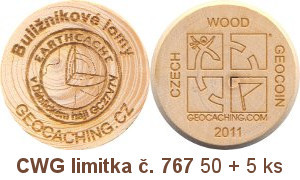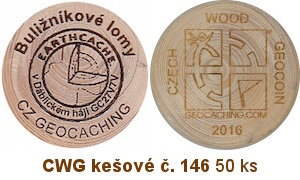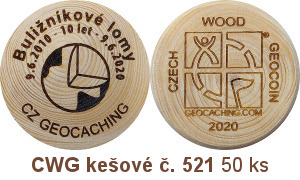Buliznikove lomy v Dablickem haji EarthCache
Buliznikove lomy v Dablickem haji
-
Difficulty:
-

-
Terrain:
-

Size:  (other)
(other)
Please note Use of geocaching.com services is subject to the terms and conditions
in our disclaimer.
[CZ]

Buližníkové lomy v Dáblickém háji

Dáblický háj je malý lesík v severní cásti Prahy, který se rozprostírá na úpatí vrchu Ládví (358 m n. m.) a je na dohled od metra Ládví. Na stanici Ládví je to shruba kilomer. Areál protínají tri hlavní asfaltové cesty, ale i množství malých cesticek klikatících se prímo v clenitém terénu. Zhruba uprostred lesa se nachází nekolik bývalých lomu a lomecku, zajímavých z geologického hlediska – jeden z nich je chránen jako prírodní památka Ládví, protože zahrnuje prílivovou kapsu s ohlazeným kamenem dokládající, že ve druhohorách byl vrch Ládví ostrovem v mori a proto v nekterých lomech najdete i buližníkové prílivové kapsy s ohlazenými balvany. Ládví je také významnou archeologickou lokalitou z období starší doby kamenné – paleolitu. Vrch Ládví je proto také chránen jako prírodní památka. Na východním okraji koncí les skalnatým výbežkem, který je místem dalekého rozhledu, predevším severním smerem, odkud je možné videt horu Ríp a další vrcholky Ceského stredohorí. Nekolik metru pod vrcholem skály stojí Dáblická hvezdárna, postavená v padesátých letech astronomickým kroužkem obce Dáblice. Pro verejnost byla otevrena v roce 1956. Puvodní stavba (východní kopule, prednáškový sál a knihovna) byla rozšírena v roce 1960 o kancelár, západní kopuli a spojovací chodbu. V roce 1968 se hvezdárna spojila se Štefánikovou hvezdárnou a od roku 1975 je tretím strediskem Hvezdárny a planetária hlavního mesta Prahy. Budete zde moci obdivovat rozkvetlé porosty hajních rostlin jako jsou sasanky hajní a pryskyrníkovitá, orsej jarní, lecha jarní, krivatec žlutý a další. Krome toho budou moci návštevníci objevoval kouzlo podvodního života v místních tuních vzniklých zatopením malých buližníkových lomu.
Proc je Dáblický háj a Buližníkové lomy vyhlášen za prírodní památku
Jedna z nejlépe dochovaných ukázek cinnosti príboje cenomansko - spodnoturonského more na území našeho státu. Výskyt fosilií vzácných druhu foraminifer. Vzhledem k zamokrení v dolní cásti lomu je území bohaté na ocasaté obojživelníky. Nachází se zde nekteré duhy teplomilného a lesního hmyzu, v zamokrené cásti lomu colek obecný. Z motýlu je tu zajímavá prežívající populace zástupce pídalkovitých Lycia isabella, z ostatních celedí jsou zde zástupci murovitých, okácovitých Aphantopus hyperanthus , babockovitých Araschnia levana a beláskovitých.
V buližníkovém lomu založeném ve dvacátých letech 20. století je v západní stene odkryta "kapsa" vzniklá v príbojovém srubu tvoreném buližníky behem cenomansko-spodnoturonské morské transgrese. V té dobe tvorily buližníky ostrov ve svrchnokrídovém mori.Kapsa je vyplnena dobre opracovanými velkými valouny buližníku o prumeru od nekolika centimetru do 2 metru. Mezerní hmotu tvorí svetle šedé vápnité jílovce obsahující relativne hojnou fosilní mikrofaunu. Melké rankerové pudy. Prírodní památka Ládví predstavuje starý lom ve smíšeném, prevážne dubovém lese zvaném Dáblický háj. Okraje lomu precházejí plynule do okolního lesa. Na dne lomu stíno- a vlhkomilné kroviny vrba obecná, krušina olšová aj. Na horní hrane nad celní stenou roste i nekolik exempláru vrby bílé.
Podmínky uznání logu:
1 - vložení fotografie (dle spoileru) do logu
na další otázky odpovezte emailem pres profil
2 - jaký oxid obsahuje buližník?
3 - na co se dríve buližník používal
Podekování
Dekujeme geokamarádce joker171 za preklad anglické cásti listingu.
[EN]

Bulizniks quarries in Dáblice grove

Dáblice Grove is a small grove in the northern part of the city, which lies at the foot of the hill Ládví (358 m) and is within sight of the Ládví metro station (about 1km). The area is intersected by three main asphalt road, but also by numerous twisting paths directly in the local rugged topography. Approximatelly in the middle of the forest are several former quarries: some small and other digger. They are interesting from a geological point of view. One of them is protected as a natural monument Ladvi. It includes tidal traces with smoothed stone that illustrates that the Ládví hill was an island in the sea during the Mesozoic Era. Therefore you can find the lydite (bulizhniks) tidal smoothed stones in some of the quarries. Ladvi is also an important archaeological site from the Stone Age - Palaeolithic. The Ládví Hill is therefore protected also as a natural monument. On the eastern edge of the forest there is a rocky extremity ,from which are perfekt views, especially northward, where it is possible to see Mount Rip and other hilltops of Ceské Stredohorí range. Several meters below the top of the rock is Dáblice observatory, built in the fifties by the astronomical association of the Dáblice village. It was opened for the public in 1956. The original building (the eastern dome, lecture hall and library) was extended in 1960 – there were built an office, the western dome, and connecting corridors . In 1968 the Dáblice observatory joined the Štefánik Observatory and since 1975 it constitutes the third center of the Observatory and Planetarium of Prague. You can admire here the blossoming vegetation of meadow plants like wood anemones, Lesser celandine, Lech spring, yellow and others. In addition, the visitors will have posibility to discover the enchantment of the underwater life in the local pools caused by the inundation of small lidyte quarries.
Why Natural Monument
Lydite (bulizhniks) quarries and Dáblice grove is one of the best preserved examples of the Cenomanian sea activities on the Czech territory. We can find there rare species of fossils Foraminifera. The bottom of the quarry area is rich in tail-amphibians due to the waterlogging. There are some kinds of thermophilic and forest insects in the swamping part and also the smooth newt. Regarding the butterflies, there is an interesting representative of the surviving population of Lycia isabella, there are also represented some Aphantopus hyperanthus and Araschnia Levante In the quarries established in the twenties of 20th century there is a kind of „pocket“ in the west wall created in the cabin wave formed during the Cenomanian-Lydites sea transgression. At that time the Lydites had been forming an island in the Upper Cretaceous see. The pocket is filled with well shaped big boulders of lydite in diameter from a few centimeters to 2 meters. The Natural Monument Ládví is an old quarry in a mixed, predominantly oak forest, called Dáblický háj. The edge of the quarry pass fluently into the surrounding forest. On the bottom of the quarry there are hydrophilic and sciophilous shrubs as willows, black dogwood and other. On the top edge grow a few specimens of white willow.
Conditions for recognition of the log:
1 - To add photos (as spoiler) to the log
and to answer and send it to the autor profile
2 - What oxide is forms port of Lydite (bulizhniks)?
3 - What was Lydite (Bulizhniks) used for in the past?
Acknowledgements
Thanks to geogirlfriend joker171 of the English listing part
Použitý zdroj a další informace:
http://www.praha-sportovni.cz
http://envis.praha-mesto.cz/%28qm0cobenqjizsu55pqcju2ml%29/default.aspx
Tato keška má i své vlastní CWG.




Additional Hints
(Decrypt)
[CZ]
Wvfgr gh xršxl arybivy, gra xqb gh zbqbh oneibh ohyvžaíx cbšxbqvy.
[EN]
Nafjre gur gjb dhrfgvbaf naq nqq gurz gb cubgb
Lbh pna gura ybt va naq nqq fbzr zbgb